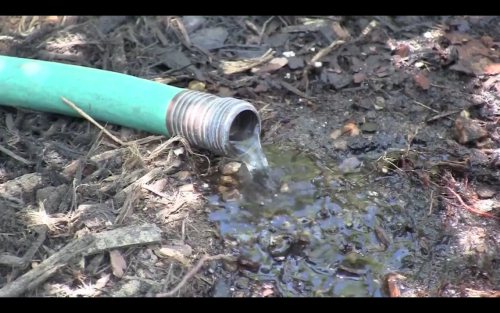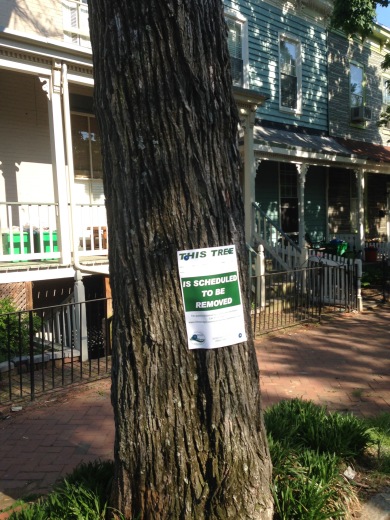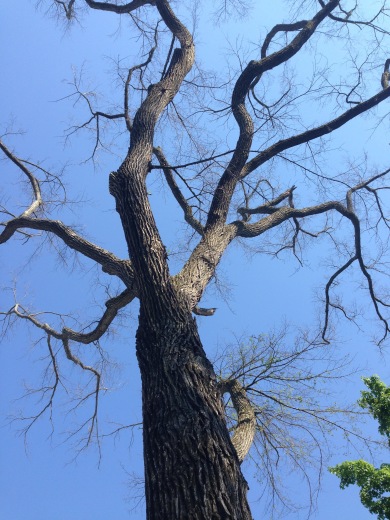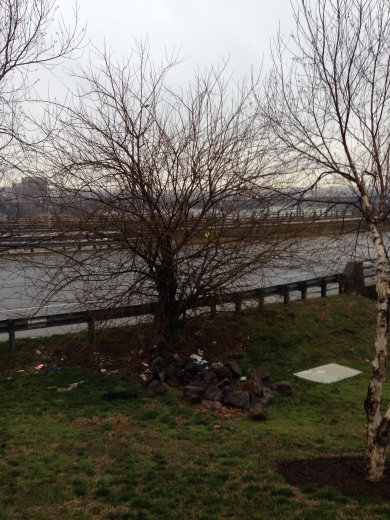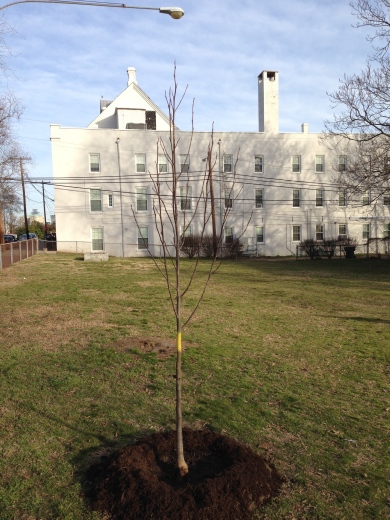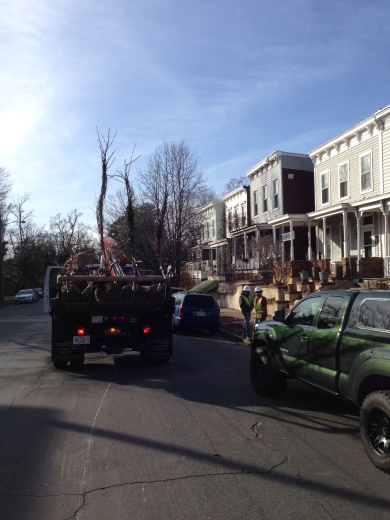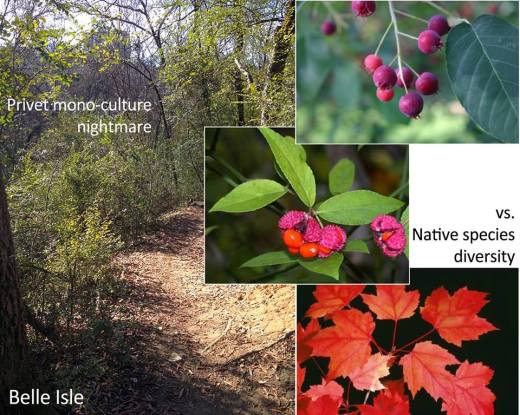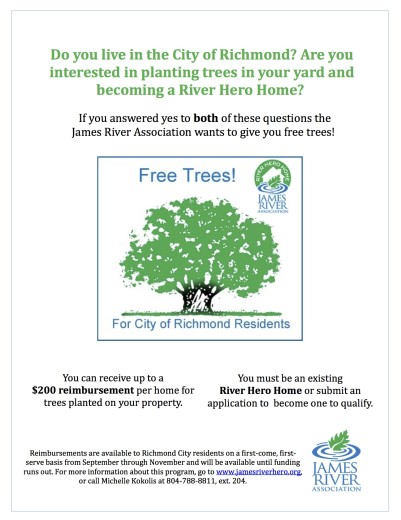Here is a list of all the plants I observed on our walk to North Bank (Oregon Hill end), broken up into sections.
Section 1: This section received a lot of south facing sun, had little to no canopy, was heavily disturbed, compacted poor soil, lots of foot and bicycle traffic, and subject to a lot of urban runoff and pollution.
Paper mulberry
privet (everywhere)
hackberry
Johnson grass
blackberry
honeysuckle (abundant)
pokeweed
lespidizia?
mimosa (abundant)
tree of heaven
black cherry tree
sweet gum
black locust
eastern red cedar
sweet potato vine
greenbiar
Virginia creeper
ragwort
dock
hops vine
daisy fleabane
morning glory
trumpet creeper
kudzu (abundant)
osage orange
bradford pear
sycamore
white pine?
Category Archives: trees
Tree Down on 500 Block of S.Laurel
Tree Stewards- “Community Roots – Let’s Plant Some Trees!”
From the Richmond Tree Stewards:

Does your yard have an empty space begging for a tree? Does you local park need some shade? Richmond Tree Stewards can help you fill that space. Our Community Roots event will offer trees free to homeowners and to community organizations (friends of parks groups, schools, etc) wishing to plant trees in the City of Richmond. The trees will be available for planting in November, the best tree planting month of the year.
The Richmond Tree Stewards, a non-profit organization dedicated to promoting and improving the health of the city’s urban forest, is sponsoring this event.
The program, in its second year, is an effort to improve Richmond’s tree canopy (which currently stands at only 40%) by encouraging and assisting community groups and homeowners to plant and care for trees. Thanks to a grant from the Overton and Katherine Dennis Foundation, 75-80 trees will be purchased for distribution as part of this event.Trees are beautiful. They clean the air, produce oxygen, cool the environment, improve water quality and provide food and shelter for beneficial animals and insects. If you want to make a difference in your community, there is no better way than by planting a tree!
Applications (for both home owners and community groups) must be received by September 20th!
Richmond Tree Stewards: Will you help water new street trees?
Richmond Tree Stewards are asking residents to help:
The forecast for the coming week is HOT and most parts of Richmond have not received an inch of rain in the last week and so…
Trees planted this year and last need help from the people who live or work near them.
A few minutes of your time and 15 – 20 gallons of water is all that’s needed to help these new trees thrive. Watering once a week would be best now; every two weeks is OK.
If you don’t have a watering bag, a slow trickle from the garden hose works well.
Let it run long enough to deliver at least 15 gallons.
This Tree
Tree Trash
The neighborhood trash situation is looking pretty good these days overall (compared to some other days), thanks to recent efforts.
(And please don’t forget about the cleanup tomorrow!)
But this poor tree, along Belvedere near the Overlook, for some reason is a trash magnet:
“Kudzu and bamboo and privet! Oh my! New list identifies invasive plants in Virginia”
A recent press release from Virginia’s Department of Conservation and Recreation:
Kudzu and bamboo and privet! Oh my! New list identifies invasive plants in Virginia
National Invasive Species Awareness Week runs through Saturday.
RICHMOND — Virginians considering adding English ivy, golden bamboo or Japanese barberry to their yards may want to reconsider. These plants — and 87 others — are on the Virginia Department of Conservation and Recreation’s new list of non-native invasive plants of the state (PDF).
While the list is helpful to land managers and conservationists, home gardeners can use it to make wise decisions about landscaping. The list is for educational purposes only and has no regulatory authority.
“Planting anything on this list could affect adjacent natural areas,” said Kevin Heffernan, DCR Natural Heritage stewardship biologist. “Gardeners should think twice about planting anything that might be aggressive in their yard, especially if they live near a park or a forest.”
Invasive plants can displace native plant species, reduce wildlife habitat and alter ecosystems. They threaten natural areas, parks and forests. In the United States, they cost an estimated $34 billion annually in economic loss.
Invasive, non-native plant species typically:
• Grow and mature rapidly.
• Produce seed prolifically.
• Are highly successful at germination and colonization.
• Outcompete native species.
• Are expensive to remove or control.DCR Natural Heritage scientists used a risk-assessment protocol to determine an invasiveness rank for each species listed. Species were assigned a high, medium or low level of invasiveness in Virginia.
The list also includes species that may not be established in Virginia but are known to be invasive in habitats similar to those found here. These are referred to as “early-detection” species. If they are discovered in Virginia, the goal for these species is eradication to prevent their establishment and spread. People who spot these in Virginia should notify DCR.
One example of an early-detection species is wavyleaf grass (PDF) (Oplismenus hirtellus subspecies undulatifolius). It’s been seen in nine Northern Virginia counties and has the potential to become widespread. A native of southern Europe and Southeast Asia, wavyleaf was first discovered in the United States in 1996 in Maryland. It ranks as highly invasive on DCR’s list.
Monitoring and preventing the spread of invasive plants is a major focus for DCR scientists and land managers. This work is often conducted with the help of volunteers. The Virginia Invasive Species Management Plan (PDF) outlines challenges and strategies associated with combating invasive plants and animals.
Many invasive plant species arrived as packing material or seed contaminants and became established. The spread of plants such as Japanese stiltgrass (Microstegium vimineum), kudzu (Pueraria montana variety lobata) and common reed (Phragmites australis subspecies australis) has wreaked havoc on Virginia natural areas.
Links to more information
Virginia Invasive Species Working Group
www.vainvasivespecies.org
Virginia Department of Conservation and Recreation – Natural Heritage Program
www.dcr.virginia.gov/natural_heritage/invspinfo.shtml
National Invasive Species Awareness Week
www.nisaw.org
New Trees!
Belle Island Habitat Restoration Work On Saturday
The Richmond Tree Stewards have a volunteer event planned for this Saturday:
We will remove invasive species, mostly privet and Japanese honeysuckle. Tree stewards, trained in invasives removal, will demonstrate proper techniques. We will mulch disturbed soil and begin to replant native trees. This will be an on-going project to restore native habitat. We hope to educate about the benefits of bio-diversity and recruit more advocates to care for Belle Isle and other James River Parks.
….
Rain date is Sunday, January 18.
For more information and volunteer sign-up, please click here for their FaceBook event page.


